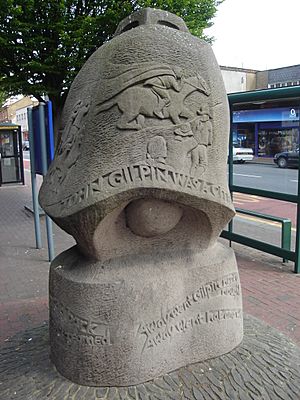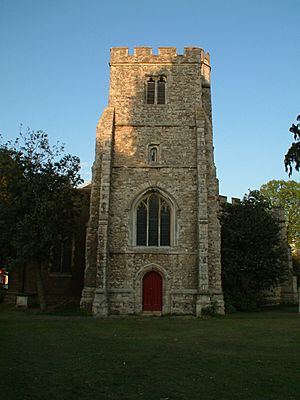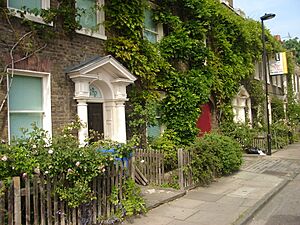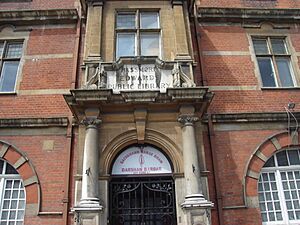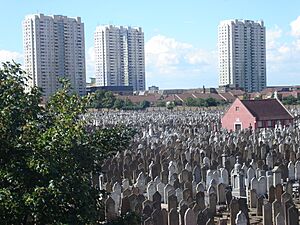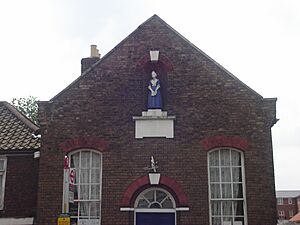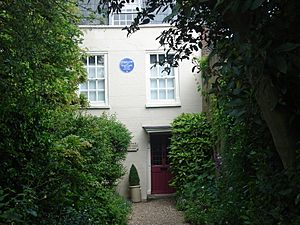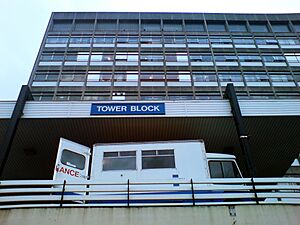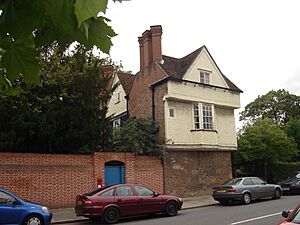Edmonton, London facts for kids
Quick facts for kids Edmonton |
|
|---|---|
 Tower blocks at Lower Edmonton |
|
| Population | 82,472 (2011 Census) |
| OS grid reference | TQ335925 |
| London borough | |
| Ceremonial county | Greater London |
| Region | |
| Country | England |
| Sovereign state | United Kingdom |
| Post town | LONDON |
| Postcode district | N9, N18 |
| Dialling code | 020 |
| Police | Metropolitan |
| Fire | London |
| Ambulance | London |
| EU Parliament | London |
| UK Parliament |
|
| London Assembly |
|
Edmonton is a busy town in north London, England. It's part of the London Borough of Enfield, which is a local government area within Greater London. The town is split into two main parts: Lower Edmonton (also called Edmonton Green) in the north, and Upper Edmonton in the south.
Edmonton is about 8.4 miles (13.5 km) north-northeast of Charing Cross, a famous spot in central London. It shares borders with Enfield to the north, Chingford to the east, and Tottenham to the south. To the west, you'll find Palmers Green and Winchmore Hill. In 2011, about 82,472 people lived in Edmonton.
For a long time, Edmonton was a quiet village. But in the 1800s, things changed a lot! When railways and tramways opened, especially the high-level train station at Lower Edmonton, the area grew very quickly. It became a busy part of London. Factories started to appear on former marshland, and many working-class families moved here.
By the 1930s, Edmonton was a popular place for shopping in north London. In the 1960s and 1970s, the town was rebuilt quite a bit. They built a large indoor market and shopping centre, plus lots of council homes, including tall tower blocks.
In more recent years, Edmonton has become one of the most ethnically diverse places in England. Many people from different backgrounds have moved here, making it a vibrant and multicultural community. This change was first noted in the 2011 census.
Did you know? In 1795, this town gave its name to Fort Edmonton. That fort later grew into the city of Edmonton, which is now the capital of Alberta, Canada!
Contents
- Exploring Edmonton's Location
- Edmonton's Past: A Look Back
- The Story of John Gilpin
- Edmonton's Industries
- Trains and Trams: How Transport Shaped Edmonton
- Edmonton Today: Modern Life
- People and Diversity in Edmonton
- Historic Places to See
- Shopping in Edmonton
- Fun and Recreation
- Arts and Culture
- Famous People from Edmonton
- Edmonton in Popular Culture
- Waterways in Edmonton
- Nearby Places
- Train Stations in Edmonton
Exploring Edmonton's Location
Edmonton is located about 8.4 miles (13.5 km) north-northeast of Charing Cross in central London. It stretches from just south of the North Circular Road, where it meets Tottenham, all the way north to its border with Ponders End.
To the west, you'll find areas like Bush Hill Park, Winchmore Hill, and Palmers Green along the Great Cambridge Road. The River Lee Diversion forms Edmonton's eastern boundary, separating it from Chingford. Lower Edmonton is in the N9 postcode area, and Upper Edmonton is in the N18 postcode area. The town is generally about 16 meters (52 feet) above sea level. The biggest public parks here are Pymmes Park and Jubilee Park.
Edmonton's Past: A Look Back

Long ago, a main Roman road called Ermine Street passed right through what is now Edmonton. This road connected London to Lincoln and then to York.
Edmonton is even mentioned in the Domesday Book from 1086! Back then, it was called Adelmetone, which meant 'a farm or estate belonging to a man named Ēadhelm'.
For centuries, Edmonton was part of Middlesex, an old county. Local government started here in 1837. The old town hall, where local decisions were made, was built in 1884. It was a beautiful building with a unique style. Sadly, it was taken down in 1989. In 1965, Edmonton joined with Enfield and Southgate to form the new London Borough of Enfield.
Pymmes Park: A Historic Green Space
Pymmes Park in Upper Edmonton has a lovely walled garden. It used to be a private estate owned by the powerful Cecil family in the 1500s. In 1589, Robert Cecil, 1st Earl of Salisbury, who was a very important person in Queen Elizabeth I's government, spent his honeymoon there. The park was bought by Edmonton Council and opened to the public in 1906. The original Pymmes House was destroyed during the Second World War.
Tales of Witches and Wizards
In the 1600s, when Edmonton was still mostly countryside, it had a reputation for strange happenings! Around 1600, a play called The Merry Devil of Edmonton was performed in London. It was about a wizard who lived in Edmonton.
Later, in 1621, villagers accused an old woman named Elizabeth Sawyer of witchcraft. She was later executed. Her story was told in a pamphlet and in a play called The Witch of Edmonton.
Famous Writers and Poets
The historic All Saints' Church is on Church Street. Nearby is Lamb's Cottage, which was home to the famous writers Charles Lamb and Mary Lamb.
The famous poet John Keats also spent time in Church Street between 1810 and 1816, learning to be a surgeon. A shop there has a special blue plaque to remember him.
Edmonton was also the hometown of Sir James Winter Lake, who was a director of the Hudson's Bay Company. This company had a trading post in Canada named after Edmonton, which is now the capital city of Alberta.
The Story of John Gilpin
In 1782, a poet named William Cowper wrote a funny poem called The Diverting History of John Gilpin. It tells the comic story of John Gilpin, a linen seller from London.
Gilpin's wife decided they should celebrate their twentieth wedding anniversary at The Bell Inn in Fore Street, Edmonton. But their journey was full of bad luck! Gilpin lost control of his horse, which carried him all the way to the town of Ware, about 10 miles (16 km) away. On the way back, Gilpin still couldn't stop his horse, and it galloped right past The Bell again! His worried wife was very upset.
Today, you can find a statue of Gilpin at Fore Street in Edmonton. There's also a pub called Gilpin's Bell and a council housing building called Gilpin House, named after him.
Edmonton's Industries
Edmonton used to be a hub for many different industries. They made things like gas appliances, electrical components, and furniture. Sadly, most of these industries closed down in the late 1900s. Some well-known companies that made goods here included MK electric, Ever Ready batteries, British Oxygen, and Glover and Main gas appliances.
The Eley Industrial Estate is named after Eley Brothers, who made firearms cartridges. Their tall shot tower was a famous landmark until it was taken down. Because Edmonton is close to the River Lee Navigation, timber was brought by barge from the London Docks and stored here. This led to many furniture makers setting up factories, like Nathans and Beautility. Today, Parker-Knoll furniture is still made in Edmonton.
Since 1971, the area has been dominated by the tall, 100-meter (328-foot) chimney of the Edmonton Incinerator. Other big employers in the area include Coca-Cola.
Trains and Trams: How Transport Shaped Edmonton
The railway first arrived in 1840. At first, not many people used the trains because the station was far away and the trains were slow. Most people preferred horse buses.
But things changed when the high-level railway opened at Edmonton Green in 1872. This, along with a tramway that opened in 1881, brought many working-class people to Lower Edmonton. It encouraged new homes to be built and helped the outdoor market at Edmonton Green grow.
By the early 1900s, Edmonton Green had become a very busy and lively place. It was full of market stalls, food sellers, and even traveling circuses and fairs! The local council tried to close the market many times, but they were never successful.
The tramway was updated and electrified in 1905, and it ran until 1938 when trolley buses took over.
Edmonton Today: Modern Life
By the 1930s, Edmonton was a big shopping destination. After World War II, many parts of the area were run down, and there weren't enough homes. In 1960, a big plan was made to rebuild the town centre. This included a new shopping area for pedestrians, parking for cars, and hundreds of new flats, including three tall 25-story tower blocks.
Building started in 1965 and finished in 1974. In recent years, Edmonton has become one of the most ethnically diverse areas in England due to more people moving here from different countries.
In 2005, a large IKEA store opened in Edmonton. The Edmonton Green Shopping Centre is currently being redeveloped. This big project will bring new homes, a new bus station, a clinic, and improvements to the shopping centre. A new Travelodge hotel is also being built.
In 2008, the then Mayor of London, Boris Johnson, visited Edmonton to talk about plans to help young people. Edmonton has faced challenges, including high unemployment, especially during the economic downturn of the late 2000s.
In 2011, over 400 people marched through Edmonton to speak out against gun and knife crime. As part of the 2012 Summer Olympics preparations, the Olympic torch relay passed through Fore Street in Edmonton in 2012.
There are also plans for a huge £1.5 billion project called Meridian Water. This will create up to 5,000 new homes and 3,000 new jobs on former industrial land by 2026.
People and Diversity in Edmonton
The Edmonton area is very diverse. In the 2011 census, a large part of the population belonged to different ethnic minority backgrounds.
The most spoken foreign language in many parts of Edmonton is Turkish.
Historic Places to See
Here are some interesting historic buildings and sites in Edmonton:
This church, mostly built in the 1400s, is the oldest building in Edmonton. You can find it on Church Street.
- Angel Place
These are old houses from around 1730. They are Grade II* listed, meaning they are very important historically. They were restored in the 1980s.
- Charles Lamb Institute
This building, designed by J. S. Alder, opened in 1908. It's a Grade II listed building and is now used as a church.
- Edmonton Central Library
This old public library opened in 1897. It was designed by Maurice B. Adams. Today, this Grade II listed building is a religious and community centre.
- Edmonton Federation Cemetery
This Jewish cemetery was started in 1889. It's a peaceful place bordered by Salmons Brook and a footpath. It also contains war graves from both World Wars.
- Edmonton Girls' Charity School
This school, founded in 1784, was built to educate girls, mainly to prepare them for domestic service. The building has a statue of a charity girl and a special message about hope and charity.
- Lamb's Cottage
This cottage, built in the 1680s, is in the Church Street conservation area. The famous writers Charles and Mary Lamb lived here from 1833 until Charles Lamb passed away in 1834.
- Millfield House
This house from the late 1700s has had many uses, including a hospital and a refugee centre. It reopened as an arts centre in 1979 and includes the Millfield Theatre.
- North Middlesex Hospital
Located in Sterling Way, this hospital was built in 1842 as a workhouse. It became a military hospital during World War I and was renamed the North Middlesex Hospital in 1920.
- Salisbury House
Dating back to the late 1500s or early 1600s, this is the oldest building in Edmonton apart from All Saints' Church. It has been a home and a school. In 1957, it became an arts centre.
- The Crescent
This is a row of twenty-five Georgian houses built between 1826 and 1851.
Shopping in Edmonton
The main shopping area in Edmonton is the Edmonton Green Shopping Centre, which has a large market. Another shopping area is at "Angel" Edmonton, which is a high street with many different shops.
Fun and Recreation
- Edmonton Cricket Club: This cricket club was founded in 1872 and is located on Church Street.
- Edmonton Leisure Centre: Opened in 2007 at Edmonton Green, it has a swimming pool and sports hall.
- Lee Valley Leisure Complex: Located at Picketts Lock, this is part of the larger Lee Valley Park.
- Pymmes Brook Trail: This walking path crosses Edmonton and connects to the Lea Valley Walk.
- You can go fishing in the River Lea.
- The River Lee Navigation's towpath is part of National Cycle Route 1 and the Lea Valley Walk, great for cycling and walking.
Parks and Green Spaces
- Bury Lodge Gardens: These gardens have beautiful pergolas, rose gardens, and a pond. There's also a playing field.
- Church Street Recreation Ground: This park has playing fields and a children's play area. It's also home to London's only complete Second World War Civil Defence Centre.
- Craig Park: Located in Upper Edmonton, this park has sports pitches and a children's play area.
- Jubilee Park: This park opened in 1939 to celebrate King George V's Silver Jubilee. It has formal gardens, sports pitches, tennis courts, and a wildlife area.
- Montagu Road Recreation Ground: This park has playing fields, a children's play area, and hard courts.
- Plevna Road Open Space: An open space close to Edmonton Green.
- Pymmes Park: This historic park is in Upper Edmonton, bordering the North Circular Road.
- Tatem Park and Hollywood Gardens: These gardens opened in 1938 and were built on a former gravel pit. They have ornamental gardens and a nature area for wildlife.
Arts and Culture
Edmonton is home to the Millfield Arts Centre and Face Front Inclusive Theatre Company, which offers inclusive theatre experiences.
Famous People from Edmonton
Many interesting people have connections to Edmonton. You can find a full list in the List of people from Edmonton, London article.
Edmonton in Popular Culture
- In the BBC comedy Some Mothers Do 'Ave 'Em, Frank Spencer roller skates down a bridge at Edmonton Green.
- The Empire Music Hall in Edmonton was where Marie Lloyd gave her last stage performance in 1922.
- The music video for the Lostprophets song "Shinobi vs. Dragon Ninja" was filmed in a car park at Edmonton Green.
- Local musicians Chas & Dave recorded a song called "Edmonton Green" about the changes in the area.
- In the TV show Birds of a Feather, the character Sharon Theodopolopodous lived in a council flat in Edmonton.
- In Harold Pinter's play The Birthday Party, there's a mention of a "world-class" concert in Lower Edmonton.
Waterways in Edmonton
- River Lee Diversion
- River Lee Navigation
- Pymmes Brook
- Salmons Brook
- The Overflow Channel: This channel flows along the western side of the William Girling reservoir and joins the River Lee diversion.
- Saddlers Mill Stream: This stream mostly flows underground and was diverted to help prevent flooding.
Nearby Places
- Tottenham to the south
- Palmers Green to the west
- Chingford to the east
- Ponders End to the north
- Winchmore Hill to the north
Train Stations in Edmonton
- Edmonton Green railway station
- Silver Street railway station
- Meridian Water railway station




